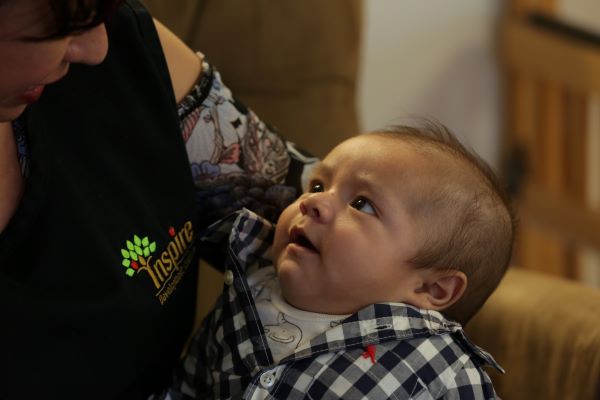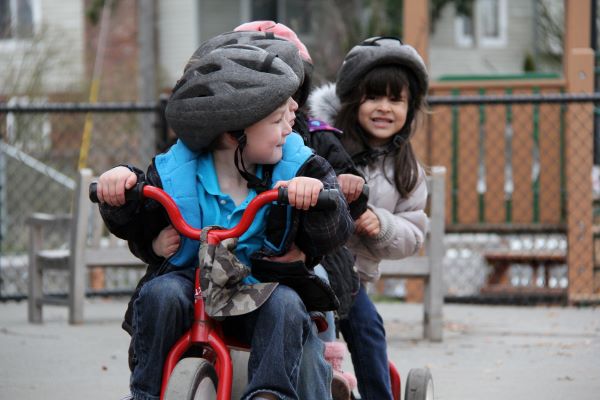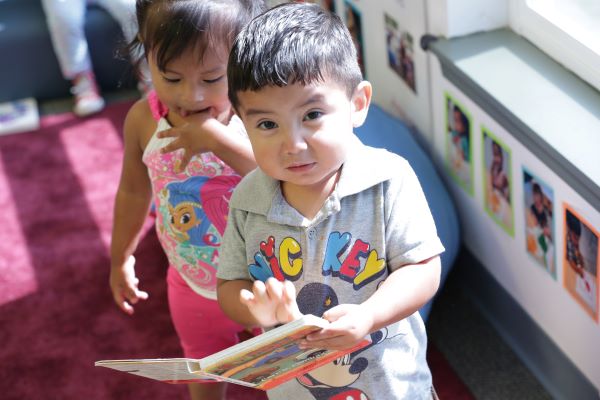Each person’s racial, linguistic, ethnic, and cultural identity is a strength to be developed and sustained while they acquire the skills they need to function in our diverse society.
Why It Matters
Beginning at birth, young children develop their sense of identity and belonging within groups. Infants and young children need adults in their lives to recognize, value, and respect their unique temperaments, preferences, strengths, and needs. A child’s identity and attachment to culture are not static but instead are continually shaped by the interactions they have with others. In the safety of these nurturing and supportive relationships, infants and young children confidently explore their environment and learn to value and respect the people within it.

- Children need guidance from adults to develop an understanding of themselves as unique individuals and members of a community. A sense of identity and belonging contributes to school readiness and learning by helping children gain self-confidence. When children feel good about themselves and what they can do, they engage more fully in learning opportunities.
- When adults encourage children to negotiate conflict and welcome differences, they nurture a caring learning community.
- Conflict between children is natural and part of identity development, empathy, and friendship skills. Research shows that while adults may want to stop conflict between children, it gives opportunities for children to learn how to cooperate and share.
- When adults model respect for other cultures, children will too. Staff model respect for other cultures by learning more about the children and families in their program.
- Staff are asked to nurture the cultural identities of young children, and their approaches and practices are influenced by their own sense of belonging within the program. When staff experience their identities embraced as strengths, it is extended to families and modeled for children.
Connections to the HSPPS
In this section, learn about example indicators for this Multicultural Principle and how they are supported by the Head Start Program Performance Standards (HSPPS). Think about your program and your learning setting. Then, consider ways you already do these practices and ways you can more closely align to improve your practice.
| Example Indicators | Connections to the HSPPS |
|---|---|
Staff notice and acknowledge the activities and contributions of each child. Staff provide opportunities for children to contribute to a caring community and a sense of belonging. Staff plan activities where children can help direct the activity and use language to express themselves. | Teaching and the learning environment, 45 CFR §1302.31(b)(2) |
Program leaders give supports for effective classroom management, positive learning environments, supportive teacher practices, and strategies for supporting children. Education staff teach children emotional literacy. | Child mental health and social and emotional well-being, 45 CFR §1302.45 |
Staff use children’s home language in learning activities. Education staff offer a variety of books and print materials that reflect children’s and their families’ lived experiences, home languages, perspectives, and cultural ways of knowing and being. | Parent activities to promote child learning and development, 45 CFR §1302.51(a)(3) |
| Leaders show respect for individual differences and cultural roots. | Personnel policies, 45 CFR §1302.90(c)(1) |
 Example Indicators and Practical Strategies
Example Indicators and Practical Strategies
Review practical strategies drawn from research and Head Start programs that promote a programs capacity to reflect and affirm the cultures of the children and families it serves.
Download the Try It! worksheet and choose one practice to focus on for one month. Use the prompts to thoughtfully plan how you will use the practice. The worksheet also includes tips for reflection after using the practice for one month.
Staff provide opportunities for children to contribute to a caring community and a sense of belonging.
- Encourage children to notice and interact with their peers. A child’s sense of belonging is rooted in how they take part in relationships with others, both similar and different from themselves.
- Teach children age-appropriate strategies to address conflict with peers. Peer-to-peer conflicts also offer opportunities for children to learn more about social rules and ways to repair peer relationships.
Staff plan activities where children can help direct the activity and use language to express themselves.
- Provide materials and activities that allow all children to participate, succeed, and be challenged to build new skills and knowledge.
- Promote children’s initiative and curiosity to encourage flexibility in thinking and problem-solving.
- Ask open-ended questions that invite children to explain, elaborate, and share their thought processes.
- Provide a safe environment so children can take safe risks and learn from them.
Staff notice and acknowledge the activities and contributions of each child.
- In home-based programs, home visitors support families to recognize their child’s efforts in learning activities and interactions.
- Notice children’s non-verbal communication that indicates interest and engagement in activities. In young infants this may be in the form of sustained gaze or reaching to an object, cooing, or mimicking of sounds made by adults.
- Intentionally connect with each child to hear their ideas and add them to learning activities.
- Ask children to share topics of interest. Children talk about ideas when engaged in play, while listening to a story or song, and while in transition between learning activities.
- Individualize expectations for child communication to include non-verbal methods, including gestures like nodding or shaking their head in agreement or disagreement.
- Invite children to share ideas and things they are interested in during mealtimes or other daily routines, allowing children to participate at their own pace.
 Leaders show respect for individual differences and cultural roots and intercultural approaches.
Leaders show respect for individual differences and cultural roots and intercultural approaches.
- Assign staff that share the home language of the children. When a majority of children in a classroom or home-based program speak the same home language, staff who speak that language are assigned (45 CFR §1302.90(2))
- Recognize and intentionally use each family’s caregiving and strategies within curricular approach, as much as possible, to individualize services and support program-family connections.
- Honor each staff member's uniqueness by engaging in cross-cultural discussions and activities that encourage understanding of staff cultural beliefs and values.
- Make sure each staff person is seen, heard, valued, and respected. Leaders use planned and impromptu conversations and activities to get to know each staff member as an individual with unique expertise, knowledge, and experience to contribute to the team’s success.
Staff use children’s home language in learning activities.
- Learn simple songs in the home languages of the children and families and share these songs in the learning environment.
- Play music that includes the home languages of the children and families.
- Invite families to share stories in their home language and in English.
- Encourage children to use words in the home language of their peers.
- When staff don’t speak the home language of the children, identify volunteers who speak children’s home languages who could be trained to work in the classroom to support children’s continued development of the home language (45 CFR §1302.31(2)(b)(iii)).
 Education staff offer a variety of books and print materials that reflect children’s and families’ lived experiences, home languages, perspectives, and cultural ways of knowing and being.
Education staff offer a variety of books and print materials that reflect children’s and families’ lived experiences, home languages, perspectives, and cultural ways of knowing and being.
- Select books and provide multiple ways for children to explore diverse cultures, identities, and experiences through reading and oral storytelling.
- Include printed signs and posters in the learning environment that reflect the multiple identities of the children, including culture, language, and ability.
- Encourage families to share stories, read books, and sing at home with their children.
- Encourage parents to share oral stories, lullabies, finger plays, chants, and nursery rhymes from their childhoods in the languages they know best.
- Offer families books from your program’s lending library or the local library.
- Ask families for book ideas to expand the program’s lending library, to represent the family’s language and culture.
Education staff teach children emotional literacy.
The way a child expresses emotion is shaped by cultural and family expectations and the child’s emotional literacy. Emotional literacy is the ability to identify, understand, and respond to emotions in oneself and others in positive ways. Children who can label their emotions are better able to communicate their feelings and have positive relationships with peers and adults. Children mimic the behaviors and emotional responses of the adults who care for them. They learn which behaviors are accepted and which are discouraged.
- Teach children to identify their feelings and those of others.
- Model expressing and labeling feelings.
- Name the feelings observed in children, and introduce songs, games, and stories that focus on naming emotions.
Voices from the Head Start Community
In this section, a Head Start program shares how they made changes to their procedures and practices following an implicit bias training revealed areas of needed improvement.
After organizing a training on implicit bias, program leadership recognized they needed to shift from what they felt was a “tourist lens” in learning about families’ cultures. They needed to take time to understand what families value, believe, and need most from the program. The program director observed:
“Equity is … about figuring out where staff [and families] are … Do the staff feel represented? Do families feel represented? Do they feel safe? How do we check off the boxes for everyone?”
Following the implicit bias training, the program took the steps described below, to make sure they were considering equity in all their systems.
Find ways to help families feel they belong.
To help families feel valued and respected, the program added inclusion and anti-bias commitment statements to their parent manual, which they plan to discuss during their next parent orientation. They also give home language surveys and make sure they use the information and follow up on any concerns.
Offer multiple formats and opportunities for difficult conversations.
When the program added an anti-bias curriculum, there was silence from staff who found it difficult to talk about their experiences.
To help them have these important, though uncomfortable, conversations, the program added them to their professional learning community. They read books and articles and talked about them in small groups. To help people feel comfortable speaking, they created groups that included staff from multiple sites, and they separated supervisors from their supervisees. The program director shared:
“How do you validate everyone’s feelings and experiences? Am I even saying the right thing? Offering large, medium, and small groups … [helps] people share. For people who do not have that experience, let’s talk about that — the feeling that you don’t feel you can relate to.”
View equitable practice as an ongoing process.
The program’s commitment to equity is ongoing and changing. Just like the Multicultural Principles, the program needs to be open and ready to change, based on its community and society. They know their practices must offer equitable service to all children and families. A program manager shared:
“So, the way we are thinking now is very different … What we want for our organization is much more about how we use it more, rather than just the once-a-year preservice. This is ongoing work.”
Reflect
Early childhood programs can use the following questions as a starting point — to take a look at the challenges they face and the approaches they might use to promote culturally sustaining and equitable practice across service delivery areas. The questions listed below are designed for self-reflection and critical assessment of practice and can also be used with groups of staff, with families, and with community partners to spark dialogue. In order to go deeper into some topics in a group setting, programs may benefit from session leaders who are skilled facilitators either among their staff or from outside their program.
- How does your program learn about the different racial, ethnic, linguistic, and cultural identities of families and staff? How are families and staff invited to share their cultures?
- How does the learning environment reflect the racial, ethnic, linguistic, and cultural heritage of children enrolled? How are families invited to share with staff what makes their family “feel at home”?
- How does the program environment reflect the cultures of staff and the cultures reflected in the community?
- Has your program updated program policies or practices to honor the diverse identities of children, families, or staff? If so, what are examples?
Deepen Your Learning
Explore these useful resources to learn more about ways to foster children’s developing sense of identity and belonging.
- Brilliant Bilingual Babies
- Dual Language Learners Program Assessment (DLLPA) Sections 3, 4, and 5
- Guide to Facilitating Dialogues
- Highly Effective Teachers Use Key Language and Literacy Strategies All Day, Every Day, with Every Child!
- Framework for Effective Practice
- Including Children’s Home Languages and Cultures
- Partnerships for Change: Listening to the Voices of Families
- Talking to Children About Differences and Similarities
- The Importance of Home Language Series
- Tips for Teachers: Dual Language Learners
- Mental Health and Equity
- Supporting Social and Emotional Well-being
Read more:
Resource Type: Article
National Centers: Early Childhood Development, Teaching and Learning
Audience: Directors and Managers
Last Updated: February 14, 2024